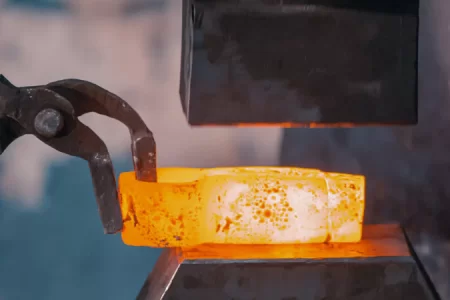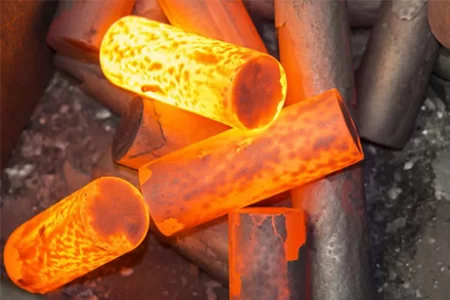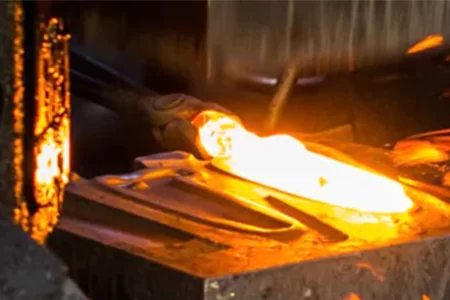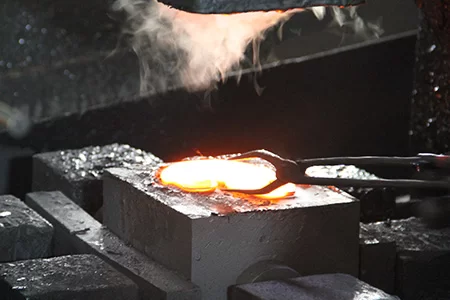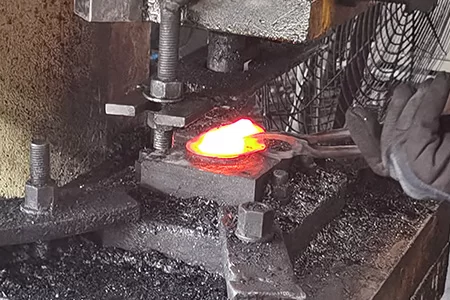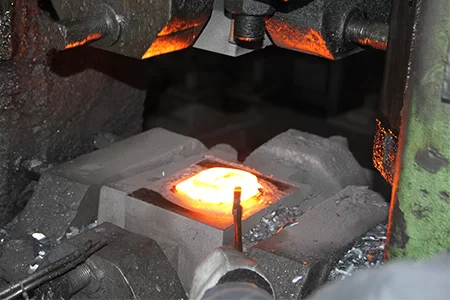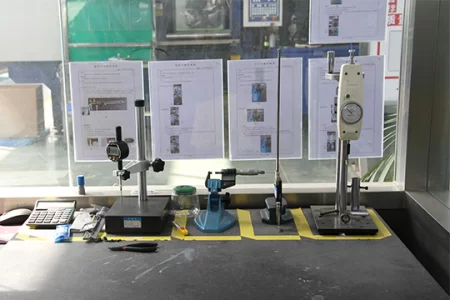By sharing knowledge, experience and views in the field of forging technology, we help you understand, learn and apply relevant technologies.

Hulk Metal Forging Technology
Share technical experience
-
Home>
-
Blog>
-
Technology>
The Difference Between Forged Lifting Hooks and Foundry Hooks

Lifting hooks are an indispensable part of lifting and rigging operations, playing a vital role in securing loads and ensuring safety during heavy-duty hoisting. From construction sites to mining operations, the reliability of lifting hooks can determine the success or failure of an entire lifting system.
Among the many types of lifting hooks available on the market, two of the most widely used are forged lifting hooks and foundry hooks. While they may appear similar at first glance, they differ significantly in terms of manufacturing process, material strength, durability, and application.
This article explores these differences in detail to help you choose the right type of hook for your specific lifting requirements. Whether you’re a procurement engineer or a field operator, understanding the distinction between these two hook types can lead to better safety, cost-efficiency, and overall performance in your lifting operations.
What Are Lifting Hooks?
A lifting hook is a mechanical device used to grab and lift loads using lifting slings, chains, ropes, or other rigging tools. It forms a critical link between the load and the lifting equipment—whether it's a crane, hoist, or lifting beam.
Lifting hooks are used across various industries including construction, shipping, oil & gas, steel fabrication, mining, and more. Given their pivotal function, they must meet stringent safety standards and be tailored to the load they are expected to carry.
Among the different categories of lifting hooks, forged lifting hooks and foundry hooks are two core options that differ in how they are manufactured and what they are best suited for. Let’s examine each one in depth.
Forged Lifting Hooks: Features and Manufacturing Process
Forged lifting hooks are produced using the forging process, where metal is heated to high temperatures and then shaped using compressive force through dies or hammers. Two common die forging methods include open die forging and closed die forging.
Key Characteristics:
Materials: Typically made from alloy steel or carbon steel, forged hooks undergo quenching and tempering heat treatments to achieve excellent tensile strength and toughness.
Structure: The forging process aligns the grain flow of the metal along the hook shape, reducing internal defects and increasing resistance to fatigue and impact.
Strength: Forged hooks can handle higher load capacities, making them ideal for heavy-duty lifting operations.
Advantages:
High mechanical performance
Excellent resistance to impact and fatigue
Superior structural integrity and reliability
Long service life under extreme working conditions
Typical Applications:
Construction and infrastructure projects
Steel coil handling
Shipbuilding and offshore applications
Mining and tunneling operations
With their proven performance, forged lifting hooks are often the preferred choice for lifting professionals who prioritize safety and durability over initial cost.
Foundry Hooks: Features and Manufacturing Process
Foundry hooks, in contrast, are made through casting processes such as sand casting or investment casting, where molten metal is poured into a mold and solidified into the desired shape.
Key Characteristics:
Materials: Commonly produced using cast iron, ductile iron, or cast steel, which are relatively more brittle compared to forged steel.
Production: Casting allows for the production of complex shapes with intricate designs at a lower manufacturing cost.
Mechanical Properties: While cost-effective, foundry hooks tend to have lower impact strength and fatigue resistance.
Advantages:
Cost-effective for mass production
Ideal for complex shapes and low-to-medium load requirements
Faster production cycles
Limitations:
Susceptible to internal defects such as porosity or shrinkage cracks
Lower load-bearing capacity compared to forged hooks
Shorter service life in demanding applications
Typical Applications:
Light-duty lifting operations
Mold and die handling
Warehouse or material transfer applications where load cycles are infrequent
Key Differences Between Forged and Foundry Hooks
To clearly illustrate the differences, here’s a comparative table:
Feature | Forged Lifting Hook | Foundry Hook |
Manufacturing Process | Hot Forging (Open/Closed Die) | Casting (Sand or Investment Casting) |
Materials Used | Alloy Steel / Carbon Steel | Cast Iron / Ductile Iron / Cast Steel |
Mechanical Strength | Very High | Moderate to Low |
Internal Defects | Minimal | Possible Porosity / Cracks |
Fatigue Resistance | Excellent | Average |
Impact Resistance | High | Low to Moderate |
Surface Finish | Requires Machining | Near-net-shape possible |
Cost | Higher unit cost | Lower for mass production |
Ideal Applications | Heavy-duty, high-frequency lifting | Light to medium-duty, low-cycle lifting |
Supporting Data:
According to a test conducted by a third-party inspection body, forged hooks exhibited 1.8 times the tensile strength of comparable foundry hooks made from ductile iron.
Fatigue testing showed that forged hooks could withstand 20,000+ cycles under 80% of the rated load, while cast hooks failed around 7,000 cycles.
The data clearly suggests that forged hooks provide superior long-term performance and are best suited for high-risk or mission-critical lifting environments.
Safety Considerations and Compliance
When choosing between forged and foundry hooks, safety compliance should be a top priority. Forged lifting hooks are more likely to comply with international standards such as:
EN 1677
ASME B30.10
DIN 15401 / 15402
These standards define design, load testing, and inspection requirements for lifting hardware. Forged hooks are typically easier to certify and trace, as forging offers better control over microstructure and defect elimination.
In contrast, foundry hooks are more prone to hidden flaws and are generally not recommended for dynamic or repetitive load applications where failure can lead to serious accidents.
Proper markings, load testing certifications, and traceable serial numbers are essential, especially for use in construction, marine, and offshore sectors.
Choosing the Right Hook for Your Application
To decide which hook to use, consider the following factors:
Load weight and frequency
Working environment (temperature, corrosion)
Safety regulations
Budget and procurement cycle
When to Choose Forged Hooks:
You need maximum strength and reliability
The application involves dynamic loads or frequent lifting cycles
Compliance with safety standards is mandatory
Lifespan and long-term cost-effectiveness are important
When to Choose Foundry Hooks:
Loads are light-to-medium weight
You require complex shapes at a lower cost
Lifting is infrequent or static
The budget is limited and safety requirements are moderate
Why Choose HULK Metal for Your Forged Lifting Hook Needs
At HULK Metal, we specialize in manufacturing high-quality forged lifting hooks using top-grade materials and precision forging techniques. Our hooks are engineered for durability, safety, and long-term performance under extreme working conditions.
Why Clients Trust HULK Metal:
In-house hot forging workshop with CNC-controlled dies
Material traceability and 100% tensile load testing
Compliance with EN/ASME/DIN international standards
Surface treatments available: zinc plating, painting, black oxide
Custom designs and dimensions available based on client drawings
We don’t just manufacture products—we deliver reliable lifting solutions backed by engineering support and global logistics service.
Request a Free Quote Today or Speak With Our Lifting Expert.
While both forged lifting hooks and foundry hooks serve the purpose of securing loads during lifting, their differences in strength, reliability, and safety compliance make them suited for very different applications.
If your operation demands high load capacity, durability, and compliance, forged lifting hooks are the superior choice. And if you’re looking for cost-effective hooks for light-duty, infrequent lifting, foundry hooks may be suitable.
Choosing the right hook is not just a matter of price—it's a matter of safety and performance. With HULK Metal, you can ensure you're getting a hook that's engineered for excellence.
Article Navigation
Article Navigation
Foundries
-

July.01, 2024
Difference between hot forging and cold forging
READ MORE
-

June.27, 2024
What are the advantages and disadvantages of the hot forging process?
READ MORE
-

January.18, 2024
Forging: What Is It? What Are The Different Types of Hot Forging?
READ MORE
-

February.28, 2025
Open Die Forging: Exploring the forging process and the key factors in selecting a OEM
READ MORE
-

February.24, 2025
Key Considerations for Closed Die Forging
READ MORE
-

February.18, 2025
Factors to consider when purchasing custom forgings
READ MORE
-

February.14, 2025
HULK Metal's hot forging quality control
READ MORE



